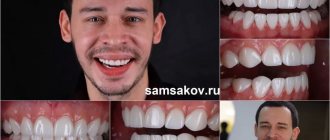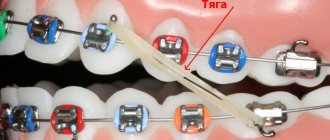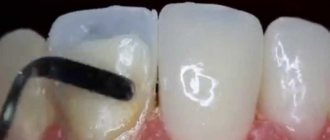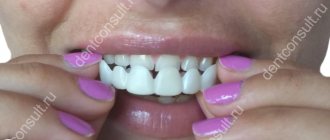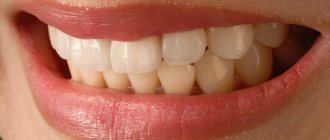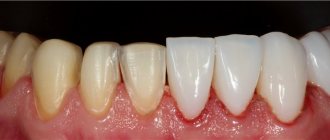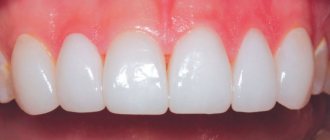Prosthetics in dentistry not only restores lost teeth, but also corrects the appearance of existing ones. For this purpose, dental veneers are used - thin decorative overlays that cover the front and bottom edges and make the teeth straight and snow-white. Patients are concerned about two questions: how long will veneers last and will it be possible to return to a natural smile if desired?
The durability of veneers depends on a number of parameters:
- material of manufacture;
- installation quality;
- loads during use.
Most likely, if you get veneers, they will last 10-12 years. This is an average and may vary in both directions. If the linings are placed incorrectly or they are tested for strength by gnawing on seeds, of course, they can crack or peel off within a year. At the same time, there are cases when veneers are worn for 30 years without the need for restoration. Look for reliable doctors, take care of your veneers, and the price will be repaid with a beautiful smile for many years.
Types of veneers for teeth
The natural appearance of teeth is very diverse. Many clients want to maintain individuality and are not interested in a “porcelain” Hollywood smile. By choosing the right material, you can not only accurately select the color of your teeth, but also maintain their transparency. So, what types of dental veneers are there?
- Ceramic. Durable, do not darken or stain over time, do not flake, do not cause irritation or allergies and look natural. They sometimes serve for 20–30 years without requiring restoration. In 90% of cases, dentists recommend ceramic veneers, especially if the entire smile area needs restoration. The cost varies depending on the manufacturer.
- Composite. They are made directly in the dentist’s office, installed in one visit, and cost 3–4 times less than ceramic ones. But they last a maximum of 5 years, are less durable and may change color. In addition, they convey the transparency of the enamel worse and generally look more “artificial.” Composite veneers are suitable when you need to restore 1-2 teeth in the smile area. They cope with this task brilliantly.
How are old veneers removed?
Since a veneer is not just a “sticker”, but a very securely attached object to a tooth, to remove it it is not enough to pick or tear it off. It is especially stupid to try to do this on your own, at home. There are only two methods - and both can only be used in a clinical setting.
Removal using a diamond dental bur
This is a mechanical veneer filing: the dentist uses a thin rotating bur to file away the veneer and the dental cement underneath, leaving only the tooth stump. Basically, this is how teeth are removed from composite veneers.
Removal using laser
Laser technology is as follows: since porcelain and ceramic veneers are very thin and characterized by a certain transparency, the laser beam simply shines through them, destroying the cement underneath. The veneer itself is not destroyed, but falls off due to the destruction of the cement layer. However, there are types of veneers (less transparent and thicker) that cannot be removed with just a laser - then a bur is used.
What determines how long veneers last?
The service life of veneers depends on:
- The material from which they are made. As we have already found out, ceramic veneers last at least twice as long as composite ones.
- Installation quality. To make your smile look natural, your teeth are ground down before installing veneers—a layer of enamel of about 0.2 mm is removed. If this is not done, the tooth will look unnaturally “thick”, and the linings themselves will not adhere well. The same thing will happen if the tooth is ground unevenly or incorrectly. This problem is especially common for composite veneers - they are thinner than ceramic ones, and if the surface is poorly prepared, a tight fit cannot be achieved. This means that pieces of food and bacteria will accumulate between the veneer and the tooth, which is dangerous not only for beauty, but also for health.
- Loads. Even durable ceramic veneers should not be tested for strength: gnawing seeds and nuts, biting a pencil, frequently eating hot and cold food. Replacing a damaged element is not difficult, but in any case it is unnecessary waste and time.
You can find out in more detail what determines how long veneers last at an appointment with the dentist, when the type and brand of veneers have been selected.
Don't forget about contraindications
When visiting a dentist, the doctor must first examine the client’s medical history, and only then make a decision about installing such plates. If there are the following contraindications, then installation is strictly prohibited.
- Caries with subsequent complications.
- Bruxism (teeth grinding).
- Major pathologies in the bite.
- Insufficient enamel or its thinness.
- The dental units did not erupt completely.
- Diseases, including periodontal disease, periodontitis and gingivitis (in these cases, preliminary treatment is necessary).
There are often cases when a doctor refuses to install veneers if there are large fillings on the teeth or they are highly fragile. Such negative aspects do not guarantee a long service life of the products, because even the most durable option can fall off after a couple of months.
How often do veneers need to be renewed and how is this done?
We have already found out how often veneers need to be renewed: ceramic once every 10-12 years, composite - every 3-5 years. Let's see what the replacement procedure looks like.
Veneers are installed in three steps:
- surface preparation - removing a thin layer of enamel to ensure a uniform fit of the lining;
- applying dental cement, which acts as an adhesive;
- fixing the lining.
To remove dental veneers and install new ones, they are actually cut down with a diamond drill or the adhesive is destroyed with a laser, after which the onlay is removed. Otherwise, they cannot be removed - the cement holds tightly. Ceramics are sometimes cleaned with a bur, after which the residue is removed with a laser. The procedure is absolutely painless, but the teeth after it look unsightly - uneven, with characteristic grooves from the drill. Therefore, immediately after removal, new overlays are installed. Orthopedic dentists (prosthetists) install veneers in Krasnoyarsk.
The only indication for replacing veneers is their destruction or change in color (for composite ones). There are no planned replacement dates. If you regularly visit your dentist, at the right time he will refer you to a consultation with a prosthetist.
When are they needed?
Veneers are thin coverings that cover the incisal edge of the tooth and its outer part.
They are created to protect the enamel from negative external influences, giving them a well-groomed and healthy appearance. They are used to eliminate the following problems:
- Chips and minor damage to the enamel to prevent consequences.
- The presence of noticeable fillings or gaps between the teeth that require camouflage.
- Incorrect positioning of teeth or minor problems with bite.
- Yellowing or darkening of the enamel, as well as discrepancies in the color of the teeth.
Veneers cannot be placed on the lateral chewing units or canines, because they are intended only for the front rows. Likewise, they are prohibited if the teeth are constantly in contact or if they are severely damaged. In the first case, there is a threat of damage to the products, and in the second, there is simply nothing to attach them to.
What will happen to veneers in 10 years?
If you have installed high-quality ceramic dental veneers, after 10 years you may not notice any changes at all. The overlays will remain as smooth and white as the day they were installed. Especially with proper care: thorough cleaning and use of professional pastes with a polishing effect.
The main dangers for veneers are mechanical damage and the accumulation of bacteria between the onlay and the tooth. In the latter case, an unsightly black border may appear along the edge of the tooth. If you take care of veneers, their service life can significantly exceed the 10 years “required” for ceramics.
In the case of componeers (composite overlays), after a couple of years you can expect darkening: the overlays become gray and look unnatural. This is how coloring products affect them: tea, coffee, chocolate, berries, beets. In rare cases, componers serve for 10–12 years, but completely lose their presentable appearance. As soon as this happens, you should immediately replace the veneers - the price will be the same as for installation.
Service life of veneers made from different materials
Ceramic veneers are made of durable and high-quality material, so in aesthetic dentistry they are considered durable. On average, ceramic veneers last 8 years, during which they do not lose their decorative qualities, color and structure.
Composite onlays are often formed by the dentist directly into the patient's mouth. A few hours after their installation, it is not recommended to drink or eat, talk a lot and mechanically disturb the teeth, since the plates need a certain time to harden. Compliance with these rules affects how long composite veneers are worn. On average, their service life is from 3 to 5 years, but with careful handling and care they can last much longer.
Zirconium veneers are not cheap, but at the same time they do not have a long service life. Zirconium oxide dental onlays last for 5–6 years, that is, they are inferior in service life to ceramic products. Despite this, the demand for these products remains high.
Porcelain veneers have increased resistance to external factors: mechanical stress, dyes, etc. They perfectly follow the shape of the tooth, and no stains or cracks form on their surface. Porcelain veneers last quite a long time - with proper care they last 15 - 20 years.
Important!
Regardless of what material was chosen by the patient for veneering, without following the appropriate recommendations, even the most expensive dental restorations will quickly become unsuitable for further wear. Any veneers need to be changed over time, but when this moment comes depends largely on the patient himself.
Choose dental veneers and enjoy your smile!
Veneers aren't for everyone, but if they're an option for you, you'll get a beautiful, natural-looking smile that will last for many years. Mira clinics use German E-Max veneers made of pressed ceramics. When you need to install veneers, Krasnoyarsk turns to us! During the examination, the doctor will find out whether veneers are suitable for you and will tell you whether you will need to pre-treat your teeth.
It happens that dental veneers are not suitable for the patient. In this case, we recommend alternatives: whitening, other types of prosthetics. We will definitely figure out how to achieve a beautiful smile. And, of course, we will answer all the questions: why not composite veneers, but ceramics, how long will they last and how to care for them.
In what cases are plates installed?
The main purpose of onlays is to eliminate aesthetic defects on the front teeth. It can be:
- Chips and cracks.
- Previously installed fillings that have changed color or cracked.
- Interdental gaps and tooth pigmentation that cannot be eliminated by professional cleaning.
- Pathological abrasion of enamel.
In addition, ceramic veneers help correct minor changes in the bite, crooked teeth, and a decrease in the volume of gum tissue.
Doctor's mistakes that affect the service life of veneers
In addition to the material, the operating time depends on the skill of the dentist. Below is a list of typical mistakes that doctors can make when installing veneers due to lack of experience and qualifications.
- Insufficient depth of tooth preparation. It primarily affects aesthetics: the veneer protrudes from the dental arch and becomes noticeable.
- Excessive preparation depth. Due to this error, dentin is exposed with subsequent decementation of the tooth. There is a risk of losing it.
- Incorrect formation of the ledge. When it is located under the gum, the fixation is weakened, and there is a risk of developing caries and decementing. If the shoulder width is too wide, dentin is exposed.
- Accidental damage to adjacent teeth when preparing contact surfaces. Provokes the development of caries.
- Sharp edges when smoothing edges. Lead to chipping of the material [1].
- Installation of veneers for malocclusion. In this case, it is impossible to ensure a tight fit of the plates, and they do not last long. First, it is necessary to carry out treatment with braces or other orthodontic structures [4].
For wearing comfort and durability of the structure, maximum fit of the veneer is required.
If this is not provided, food will get stuck between the tooth and the structure. As a result, bad breath occurs, and the linings may chip or stain. Fedotova E. A., Ph.D., orthopedic dentist, teacher at PSPbSMU named after. Pavlova [4].
"Hollywood" porcelain veneers
Special mention should be made of the so-called “Hollywood” veneers or lumineers (from the English luminary - luminary). These microprostheses have been decorating the smiles of American celebrities for 20 years now. Lumineers were once preferred by George Clooney, Tom Cruise, Angelina Jolie, Gwyneth Paltrow and other stars.
Lumineers are made from the strongest ceramics and are only 0.2-0.3 mm thick. The method of their production is patented and kept secret. These are the only microprosthetic onlays that are fixed to unground teeth.
Pak Roman Vladimirovich
Specialization: orthopedic dentist Work experience: more than 25 years Place of work: Dentistry ROOTT m. Butyrskaya/dd> Specialist in the field of dental prosthetics:
- microprosthetics – veneers, inlays (ceramic, based on precious metals), stump inlays;
- fixed prosthetics with solid cast, metal-ceramic, all-ceramic, metal-ceramic based on drags. metal structures;
- prosthetics on implants;
- removable prosthetics – production of complete, partial, nylon, clasp removable dentures with various types of locking fasteners and a telescopic fixation system.

